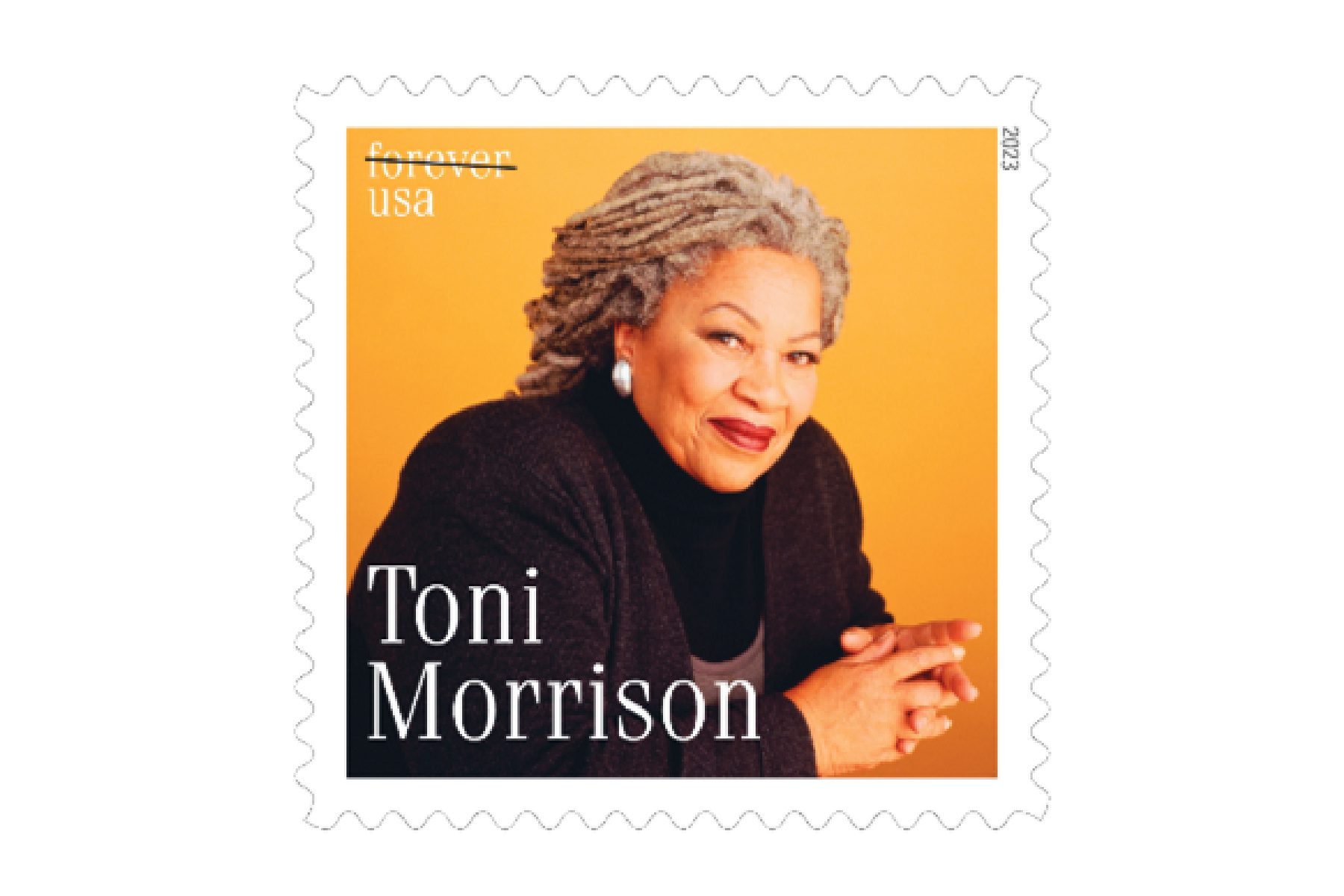We’re telling the untold stories of women, women of color and LGBTQ+ people. Subscribe to our daily newsletter.
A Nobel laureate, Pulitzer Prize winner and Presidential Medal of Freedom honoree, Toni Morrison accomplished a staggering list of feats as a writer and scholar. More than three years after her death at 88 in August 2019, she continues to achieve.
Her latest honor?
Morrison is the newest face of the Forever stamp from the United States Postal Service. Set against a gold background, a photo of the “Beloved” author with a cherry-red smile, thick gray locs and silver orb earrings graces the stamp revealed last week at a Princeton University ceremony attended by her son Ford Morrison and other relatives. A faculty member from 1989 to 2006, Morrison was the Robert F. Goheen professor in the humanities at Princeton and part of the university’s creative writing program.
Each year, the Postal Service chooses up to 30 people to feature on a stamp, selecting them from a list of 30,000 individuals recommended by the public. Morrison made the cut because of her “extraordinary and enduring contributions to American society,” a Postal Service spokesperson said in a statement.
This recognition comes as Morrison’s books are frequent targets of censorship efforts. Largely led by conservative politicians, the bans often single out books by women, people of color and LGBTQ+ writers that address race and gender specifically, as Morrison’s works do.
-
More from The 19th
- Barbara Johns made civil rights history at 16. Her sister reflects on the US Capitol statue planned in her honor.
- Mothers of the movement: Black environmental justice activists reflect on the women who have paved the way
- U.S. Mint announces final 5 women as it finishes its quarters program in 2025
To date, nearly 50 Black women have appeared on U.S. postage stamps. Among them are novelists and poets including Nella Larsen, Anne Spencer, Maya Angelou, Zora Neale Hurston and Gwendolyn Brooks. Some of the Black women on postage stamps, such as Angelou and pilot Bessie Coleman, also appear on U.S. currency via the American Women Quarters Program, which runs through 2025. And there has been an ongoing effort to get another, the abolitionist and formerly enslaved Harriet Tubman, on the $20 bill.
The Morrison commemorative stamp was designed by Ethel Kessler and features a 1997 picture of the author by photographer Deborah Feingold for Time magazine. The unveiling ceremony included statements about the late novelist sent in by former President Barack and First Lady Michelle Obama. President Obama awarded Morrison the Presidential Medal of Freedom in 2012.
“We’re honored to join Toni Morrison’s family and everyone gathered here in celebrating one of the world’s greatest storytellers,” the Obamas said in a joint statement. “Toni told fundamental truths about our country and the human condition. But she didn’t just reflect what was true. She helped generations of Black Americans reimagine what was possible. That’s why we return to her stories again and again, finding new meaning each time.”
Oprah Winfrey — who interviewed Morrison on “The Oprah Winfrey Show,” selected four of Morrison’s books for Oprah’s Book Club and adapted “Beloved” into a major motion picture in 1998 — also provided a statement for the stamp unveiling.
“Toni Morrison’s books are in so many of our homes and abide in our hearts because she served as a catalyst for generations of readers over the years to understand the power of reading and words,” Winfrey said.
Carla Hayden, the 14th librarian of Congress, attended the ceremony and discussed the important role Morrison’s books play in library collections.
Despite their literary merit, Morrison’s books are increasingly being removed from school libraries, an effort that dates back decades. “The Bluest Eye” faced book bans years before Morrison died because it depicts child sexual abuse. In 1998, the Texas Department of Criminal Justice banned Morrison’s novel “Paradise” from prisons because it “contains material that a reasonable person would construe as written solely for the purpose of communicating information designed to achieve a breakdown of prisons through inmate disruption such as strikes or riots.” In the 2019 documentary “Toni Morrison: The Pieces I Am,” the author revealed that she had framed the letter informing her of the book ban. Upon learning that prison officials believed her novel was capable of inciting a riot, Morrison thought to herself, “How powerful is that?” she recalled with a chuckle.
Since her death, efforts to ban her works have intensified due to a censorship movement that’s swept much of the country during the pandemic, resulting in the purging of more than 1,600 unique book titles from schools between 2021 and 2022. Both “The Bluest Eye” and “Beloved,” which feature racial and sexual violence, are among the nation’s most challenged books in schools.
“What’s important to understand is that these groups that want to remove books from schools or that think any sex in library [books] . . . should be considered pornographic and therefore unallowable — they’ve been around for a while,” Jonathan Friedman, director of free expression and education at PEN America, a freedom of expression advocacy group, told The 19th in August. “But what’s different is they are now seizing political power. They’re finding allies in positions of real influence in government, and they are trying to sort of combine pressure that they can apply locally with pressure that can be applied politically to achieve the goal, and they’re succeeding.”
In fact, a 2021 campaign ad for then-Virginia gubernatorial candidate Glenn Youngkin featured a parent who objected to her son having to read Morrison’s “Beloved” for school. The ad sparked a debate about parental oversight of school curricula that contributed to Republican Youngkin defeating Democrat Terry McAuliffe.
Although many of Morrison’s books have mature themes, she wrote all sorts of works — from essay collections to the children’s books she co-authored with her son Slade Morrison, who died in 2010 after developing pancreatic cancer. To celebrate her vast body of writing, Princeton University has organized a series of events during the 2022-23 school year, including the “Toni Morrison: Sites of Memory” exhibition at the Princeton University Library. The exhibit features dozens of pieces from the Toni Morrison Papers collection that offer insight into the author’s writing process.
In 2021, I wrote a book published by Fortress Press that explores the role of magic, culture and religion in Morrison’s writing and upbringing. It is called “Toni Morrison’s Spiritual Vision: Faith, Folktales, and Feminism in Her Life and Literature.”
Princeton University President Christopher L. Eisgruber said during the stamp unveiling ceremony that Morrison continues to be an inspiration.
While this marks Morrison’s first time on a stamp in the United States, it is not the author’s first appearance on a stamp globally. After she won the Nobel Prize in Literature in 1993, Sweden honored her with a stamp. Seven years later, the Republic of Palau in Oceania featured Morrison on a stamp for its Visionaries of the 20th Century series.
During the Princeton unveiling ceremony, Ford Morrison expressed appreciation for the stamp of his mother in her own country.
“It’s a great honor, and it’s been overdue,” he said.






